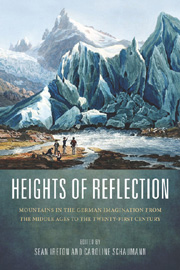 Heights of Reflection
Heights of Reflection Book contents
- Frontmatter
- Contents
- Acknowledgments
- Introduction: The Meaning of Mountains: Geology, History, Culture
- Prelude: Classical Mountain Landscapes and the Language of Ascent
- Part I First Forays: Mountain Exploration and Celebration from the Middle Ages to the Eighteenth Century
- Part II Beckoning Heights: Summits Near and Far in the Nineteenth Century
- Part III Modern Expeditions and Evocations: Climbing from the Twentieth into the Twenty-First Century
- Leaving the Summit Behind: Tracking Biographical and Philosophical Pathways in Richard Strauss's Eine Alpensinfonie
- Elevation and Insight: Thomas Mann's Der Zauberberg
- “The Essence of the Alpine World Is Struggle”: Strategies of Gesundung in Arnold Fanck's Early Mountain Films
- “Mountain of Destiny”: The Filmic Legacy of Nanga Parbat
- Spatial Orientation and Embodied Transcendence in Werner Herzog's Mountain Climbing Films
- W. G. Sebald's Magic Mountains
- Conflicting Ascents: Inscriptions, Cartographies, and Disappearance in Christoph Ransmayr's Der fliegende Berg
- Works Cited
- Notes on the Contributors
- Index
Leaving the Summit Behind: Tracking Biographical and Philosophical Pathways in Richard Strauss's Eine Alpensinfonie
from Part III - Modern Expeditions and Evocations: Climbing from the Twentieth into the Twenty-First Century
Published online by Cambridge University Press: 05 February 2013
- Frontmatter
- Contents
- Acknowledgments
- Introduction: The Meaning of Mountains: Geology, History, Culture
- Prelude: Classical Mountain Landscapes and the Language of Ascent
- Part I First Forays: Mountain Exploration and Celebration from the Middle Ages to the Eighteenth Century
- Part II Beckoning Heights: Summits Near and Far in the Nineteenth Century
- Part III Modern Expeditions and Evocations: Climbing from the Twentieth into the Twenty-First Century
- Leaving the Summit Behind: Tracking Biographical and Philosophical Pathways in Richard Strauss's Eine Alpensinfonie
- Elevation and Insight: Thomas Mann's Der Zauberberg
- “The Essence of the Alpine World Is Struggle”: Strategies of Gesundung in Arnold Fanck's Early Mountain Films
- “Mountain of Destiny”: The Filmic Legacy of Nanga Parbat
- Spatial Orientation and Embodied Transcendence in Werner Herzog's Mountain Climbing Films
- W. G. Sebald's Magic Mountains
- Conflicting Ascents: Inscriptions, Cartographies, and Disappearance in Christoph Ransmayr's Der fliegende Berg
- Works Cited
- Notes on the Contributors
- Index
Summary
When Richard Strauss conducted his Eine Alpensinfonie (An alpine symphony) for the first time in Berlin on 28 October 1915, he offered images of nature through musical means. This, of course, was by no means groundbreaking: Antonio Vivaldi's Le quattro stagioni (The four seasons, 1725), Joseph Haydn's Die Schöpfung (The creation, 1798), Beethoven's Pastoral, his Sixth Symphony (1808), and Bedrřich Smetana Vltava (Die Moldau, 1882) had already rendered nature in a musical language of its time. But what was innovative on that October night in 1915 was that a symphony presented an extensive mountain tour into the Alps. The musical excursion offered many subplots, all written into the score as follows:
night, sunrise, the ascent, entry into the forest, wandering by the brook, at the waterfall, apparition, on flowering meadows, in the Alpine pasture, wrong path in the thicket and undergrowth, on the glacier, dangerous moments, on the summit, vision, mists rise, the sun gradually becomes obscured, elegy, calm before the storm, thunder and tempest, descent, sunset, dying away of sound (Ausklang), night.
In order to track this arduous musical journey, including its dark beginning and mysterious, sinister ending, one can choose various pathways, among them biographical and philosophical paths that elucidate why Strauss chose to evoke these images and this narrative of Alpine nature. In this essay, I suggest that multilayered biographical stories and the philosophical concept of Nietzsche's Antichrist are prerequisites for explaining how Strauss conceptualized his Alpensinfonie as he did, and why he ended in a somber mood, leaving, in the end, the summit behind.
- Type
- Chapter
- Information
- Heights of ReflectionMountains in the German Imagination from the Middle Ages to the Twenty-First Century, pp. 231 - 247Publisher: Boydell & BrewerPrint publication year: 2012
